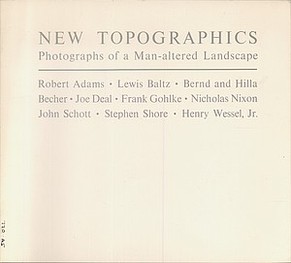 In 1975, an exhibition entitled 'New Topographics: Photographs of a Man-Altered Landscape' debuted at the George Eastman House International Museum of Photography in New York. It was the first public gathering of an original and subsequently highly influentual style of landscape photography. Ten artists working with a similar intent were selected by curator William Jenkins under a philosophy designed to more accurately represent the modern American landscape. The ten artists of the exhibition: Lewis Baltz, Joe Deal, Robert Adams, Frank Gohlke, Henry Wessel Jr, John Schott, Nicholas Nixon, Stephen Shore and Bernd and Hilla Becher, were all technically adept photographers with unique vision and an interest in aesthetic theory, and almost all went on to great success. Three of the artists were commissioned by the French government for the 'Mission de la DATAR', an agency that hired photographers to document the French landscape, and their combined influence on photography can still be seen today with many European and American photographers, such as Andreas Gursky, Nathan Ian Anderson and Toshio Shibata, emulating the style and philosophy of the exhibition. The exhibition was to be a counterpoint to the aesthetics of the traditional landscape photography of artists such as Ansel Adams, Edward Weston or Timothy O’Sullivan, which Jenkins argued was compromised by an overly romanticised and restrictive view of America. This rebellion against what they considered to be an archaic form of photography attempted to be all encompassing; the artists proposed a different approach to almost all aspects of composition, presentation and subject matter in their work. The vision of this new collective was to present work that expressed modern America with neutrality and a lack of judgement or, as Jenkins puts it, "[eschewed] entirely the aspects of beauty, emotion and opinion". This was an unrealistic aim, as ‘entirely’ eschewing these aspects would surely prevent promoting these works as valuable and nullify the arguments put forward by the artists regarding consumption and ecology. Therefore, upon examination, the proposal seems disingenuous, but it was likely proposed as inspiration for a particular focus rather than as a true goal. The alignment with the historical or scientific field of topography rather than another art movement or aesthetic principle represented an attempt to distance the work from the commonalities of landscape photography. However, the artists did take inspiration from a wide variety of sources in photography: Edward Ruscha (in particular his books "Twentysix Gasoline Stations" and "Thirtyfour Parking Lots"); Robert Frank and Walker Evans were explicitly mentioned by Jenkins as influences; Dorothea Lange, Eugène Atget, and Minor White could also be seen as guiding forces. These social realist and landscape photographers focused on the sections of American society and environment which were, in the opinion of the New Topographers, greatly unappreciated.
3 Comments
|
Archives
November 2023
Categories
All
LinksWriting
Art & Design Science Music Film All contributions by Kieran Gosney unless otherwise stated.
© Kieran Gosney and kierangosney.com, 2013. Unauthorized use and/or duplication of this material without express and written permission from this blog’s author and/or owner is strictly prohibited. Excerpts and links may be used, provided that full and clear credit is given to Kieran Gosney and kierangosney.com with appropriate and specific direction to the original content.
|
 RSS Feed
RSS Feed